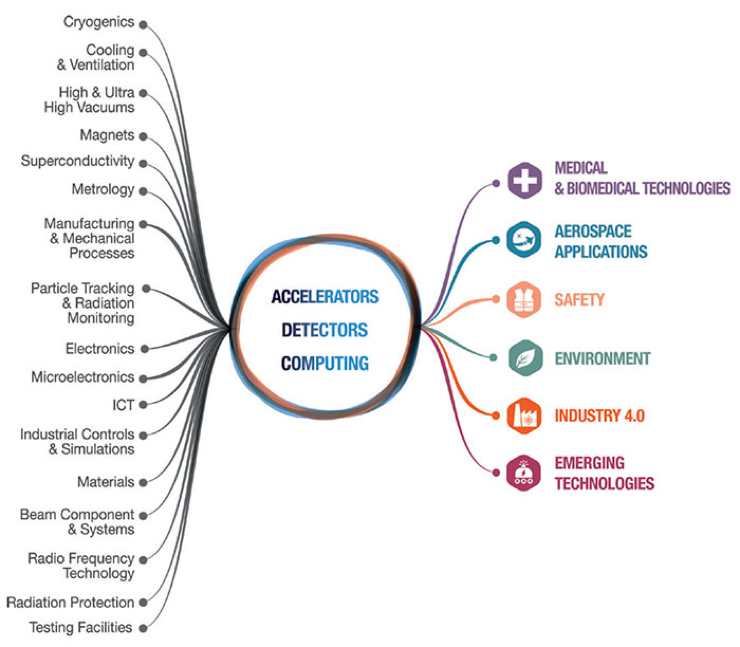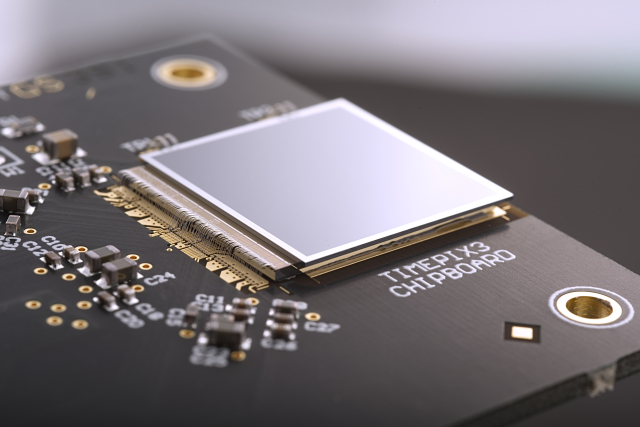Twenty years ago, in 1997, CERN set up a reinforced policy and team to support its knowledge- and technology-transfer activities. As a publicly funded Laboratory, CERN has a remit to ensure that its technology and expertise deliver prompt and tangible benefits to society wherever possible. Through novel developments in the field of accelerator technologies and detectors, and more recently in computing and digital sciences, CERN technologies and know-how have contributed to applications in many fields, including the World Wide Web, which was invented at CERN by Tim Berners-Lee in 1989.
Today, these activities are still going strong, and CERN’s influence has broadened. Its knowledge-transfer activities have had an impact on a wide range of fields, from medical and biomedical technologies to aerospace applications, safety and “industry 4.0”.

Early activities at CERN relating to medical applications date back to the 1970s. In the 1990s, the Crystal Clear and Medipix collaborations started to explore the feasibility of developing the technologies used in the LHC detectors for possible medical applications, such as PET and X-ray imaging. The Proton-Ion Medical Machine Study (PIMMS) was launched at CERN with the aim of producing a synchrotron design optimised for treating cancer patients using protons and carbon ions. The initial design evolved into the machine built for the Italian National Centre for Oncological Hadrontherapy (CNAO). Later on, MedAustron in Austria built its treatment centre based on the CNAO design. For the past 50 years, CERN has hosted the ISOLDE facility. Over 1200 radioisotopes from more than 70 chemical elements have been made available for fundamental and applied research, including in the medical field. Today, activities pertinent to medical applications are happening throughout CERN and, in June 2017, the CERN Council approved a document setting out the “Strategy and framework applicable to knowledge transfer by CERN for the benefit of medical applications”.

CERN’s computing expertise is also finding applications in aerospace. To solve the challenge of sharing software and codes in big-data environments, researchers at CERN have developed a system called CernVM-FS (CERN Virtual Machine File System), which is currently used in high-energy physics experiments to distribute around 350 million files. The system is now also being used by Euclid, a European space mission that aims to study the nature of dark matter and dark energy, to deploy software in its nine science data centres.
“Industry 4.0” is a push towards increasing automation and efficiency in manufacturing processes with connected sensors and machines, autonomous robots and big-data technology. In the field of robotics, CERN has developed TIM (Train Inspection Monorail), a mini-vehicle that monitors the LHC tunnel autonomously while moving along tracks suspended from the ceiling, and can be programmed to perform real-time inspection missions. This innovation has already caught the eye of industry, where it could be used in particular for the autonomous monitoring of utilities infrastructure, such as underground water pipelines.
Since the early days of technology transfer, CERN has continued to build a general culture of entrepreneurship within the Organization through many different avenues. In order to assist entrepreneurs and small technology businesses in taking CERN technologies and expertise to the market, CERN has established a network of nine Business Incubation Centres (BICs) throughout its Member States. The BIC managers provide office space, expertise, business support, access to local and national networks and support in accessing funding. There are currently 18 start-ups and spin-offs using CERN technologies in their businesses, four of which joined BICs last year alone.
Many other interesting projects are also in the pipeline. CERN’s expertise in superconducting technologies can be used in MRI machines and gantries for hadrontherapy, while its skill at handling large amounts of data can benefit the health sector more widely. In other fields, detector technologies developed at CERN can be used in non-destructive testing techniques, while compact accelerators benefit the analysis of artwork. These are just some examples of the new projects we are working on, and more initiatives will be launched to meet the needs of industrial and research partners in CERN’s Member States and Associate Member States over the next 20 years and beyond.
This article is a condensed excerpt from a feature article published in the CERN Courier September 2017 issue, which you can read in full here. Find out more at kt.cern.

